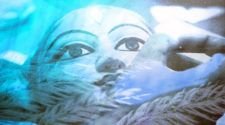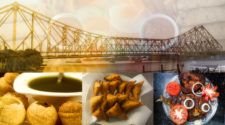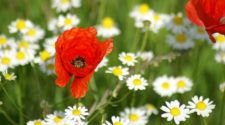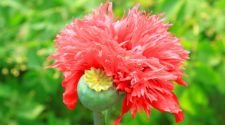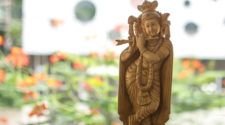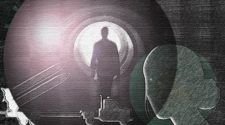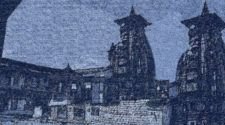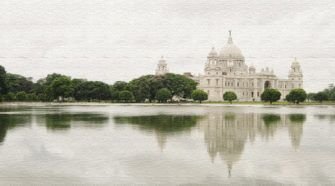In Hinduism – Vishnu, sometimes referred to as Narayana (Preserver of the Worlds) is considered to be the God of Preservation (Palan-Kartaa), of Protection (Raksha-Karta) and of Righteousness (Dharma-Sansthaapak). In Vaishnavism that embraces the largest section of followers of Hinduism, he is considered to be Brahman or Adwaita, the supreme, non-dualistic and formless entity (Niraakar-Nirguna) that is responsible for the sustenance of the living-beings (All creatures being his parts, having appeared in a specific ‘Akaar’ or form) and for granting them Moksha (Final Salvation or Emancipation) after their death, whereby their souls are said to get fused into his existence (Infinity). He is also known as Padmanavam or someone who has a lotus arising through his naval (Symbolic Purity along with Unbiased and Futuristic Vision towards the Greater Good).
Even if we consider the tradition of Hinduism as a whole, Vishnu is one of the most important Gods of the ‘Trinity’, the other two being Brahma (Creator of the Worlds) and Shiva (Destroyer of the Worlds). Accompanied by his consort Lakshmi, Vishnu is said to reside at Vaikuntha or Kshir Sagar and the abode is protected by Adi-Sheshnag (Immortal-King of Serpents, who holds the entire Universe together) who is depicted as forming a shelter on top of his head. Generally he is portrayed as having a blue, purple or black complexion and four arms carrying Kaumodaki Mace, Panchajanya Conch, Sudarshan Chakra (Disk) and a Lotus. However, in some accounts, Saraswati and Ganga were mentioned as his consorts, whereby after a tiff between them and Lakshmi, Vishnu sent Saraswati to Brahma and Ganga to Shiva.
During Samudra-Manthan (Churning of the Ocean) to obtain Amrita (Nectar of Immortality), when the Asuras (Demons) and Devas (Gods) succeeded in their efforts and started competing among themselves to obtain the Nectar, Vishnu had taken the form of a beautiful lady named Maya in order to obtain the nectar for the Devas, ultimately helping them to gain immortality.
Vishnu is said to have appeared in various incarnations in order to preserve the divine balance or synchronization of natural elements. These incarnations are known as ‘Avatars’ and there being ten of them that are considered to be the prominent ones, the avatars are mentioned as the ‘Dashavatara’. Going by the generally accepted chronology, here’s a list of the Avatars, along with a brief description of the Avatar, though the versions of certain stories may greatly vary from one Purana to another.
Matsya (Fish): In Hindu mythology the creation and destruction of the worlds are considered to be a cyclical process. The Creation itself lasts for a specific period of time known as ‘Kalpa’. After the specific time-period is over, a Pralay (Celestial Catastrophe) initiated by Shiva destroys the creation for Brahma to recreate it. The cataclysmic events that occur during Pralay, exterminate all forms of life, except a few chosen forms, which with the help of Vishnu, restore the circle of life, in a world-reborn.
The story begins in the present ‘Kalpa’ with the seventh Manu called Vaivaswata Manu (Progenitor of Humans) the son of God Surya (Sun), who, while residing by the side of a river named Kritamaala, had decided to go through severe penance for the sake of humanity. One day, while paying a minimalist water-tribute (Tarpana) to his deceased ancestors, he noticed a tiny fish swimming in the water. The little fish requested Manu not to throw him back into the river, as bigger fishes would consume him. Manu felt pity for his little friend, brought him back to his home and kept him inside a clay-pot filled with water. However, soon he realized that the fish had grown so huge, that the clay-pot didn’t have enough space to accommodate him. Next day he carried the fish to a pond, then to a river and eventually to the sea, but the fish kept growing to occupy every bit of space available in any accommodation arranged by Manu. Soon a horn emerged on the top of the golden fish, and the water-unicorn started talking like a human. Replying to the queries of Manu, the fish introduced himself as an Avatar of Vishnu and warned Manu that after seven days, it would be the time for a ‘Pralay’, whereby the entire planet would be submerged in water. He directed Manu to assemble two specimens of all known mortals within seven days, inform the Saptarishis to join him on a mission to survive and thereafter wait for an enormous boat that would come to Manu, floating out of nowhere. Once the boat appears, Manu’s friend, the fish would return to him. Manu and his team would need to tie the boat to the horn of the fish and take shelter inside the boat, while the fish would carry them safely through the oceans, till the time the disaster meets its end.
Seven days after the conversation that the two friends had, the natural calamity originated in form of heavy showers that did not stop till the oceans flooded. In time the boat decided to show up and the fish arose from the tempestuous waves of the ocean. He carried the team safely through the oceans, till the time the Sun-God ascended in the east, for them to start anew, for one more ‘Kalpa’.
Kurma (Tortise): Once the Devas and Asuras came to know of a process to churn the ocean using ‘Mount Mandara’ as the churning-pole and ‘Vasuki -The Serpent’ as the rope that was to be pulled by Asuras and Devas from two opposite directions. The outcome of the churning was in form of a reward called ‘Amrita’ that would offer one of the teams, the gift of ‘Basic Immortality’. However, as soon as the two teams began churning the ocean, the mountain started to get drilled into the ocean due to the immense weight it could generate on the surface below the ocean. At this point of time, the Gods could not come up with a resolution to get the mountain freed from the standstill. Why they had to reach out for Vishnu, who took the form of a tortoise and stood below the mountain providing it with the much needed support to avoid the deadlock. In turn, the two teams could churn the ocean and successfully find the nectar of immortality.
Varaha (Boar): Hiranyakshya and Hiranyakashipu were two brothers of an Asura clan and were considered to be the most powerful demons of their era. For the Gods they had turned up into nightmares. Hiranyakshya was said to be the stronger of the two. During his childhood, he used to ride either an elephant or a lion, get hold of the Sun and play with him as if he were a toy. One day he picked up our mother earth and took a dip in a divine water source, never to return it to the Universe. Brahma the creator of the world had no other way but to inform Vishnu of Hiranyakshya’s actions. As the protector of the planet, Vishnu had to take the form of a boar, come out of a nostril of Brahma and start chasing Hiranyakshya into the divine flow of the Universe. Vishnu instructed his follower Sage-Narada to keep drinking the waters of the water source, till the time he could defeat Hiranyakshya. After the boar had fought with Hiranyakshya for five hundred years, Narada realized that he had drunk all the water from the source. The two warriors were still battling it out and fought for another five hundred years, before the boar killed Hiranyakshya and returned the planet to Brahma.
Narasimha (Lion-Man): When Hiranyakashipu, the brother of Hiranyakshya, came to know about his brother’s death, he made up his mind to get his revenge on the Gods and especially Vishnu. So he started a penance to Brahma the creator and continued it for ten thousand years till the time Brahma had to offer him a boon. Hiranyakashipu asked for a specific benefit as to no entity taking the form of a creature that is created by Brahma, would be capable of killing him. Brahma had to grant him the boon, and Hiranyakashipu immediately declared a war against the Gods (In Human Form), defeating all of them, driving them out of ‘Swarga’ (Heaven). Then he started torturing the commons and killing the followers of Vishnu. The Gods went to Vishnu and asked for his help. In the meantime Hiranyakashipu realized that his own son Prahlada was also a follower of Vishnu. This made Hiranyakashipu go mad in anger and he tried to kill Prahlada again and again, but all in vain. He called upon his sister Holika who had a cloak that prevented her from being harmed by fire. Holika sat on a bonfire with Prahlada on her lap, in an effort to burn him at the stakes. However, a divine breeze blew and the cloak flew all by itself to cover Prahlada while Holika burnt to death. Now it was time for Hiranyakashipu to take care of the matters himself. He called upon Prahlada and asked him where Vishnu was hiding. To which the child replied that Narayana wasn’t hiding and that he was present everywhere including all around Hiranyakashipu. Hiranyakashipu asked Prahlada, if Vishnu was present inside a pillar that stood in front of them, to which the boy nodded. Hiranyakashipu dragged his sword and attacked the pillar, breaking it into pieces, but the very next moment Vishnu came out of the pillar in form of a half human and half lion creature (Nothing Like Anything Created by Brahma), tore Hiranyakashipu apart and started drinking his blood, in the process, killing all other Asuras present there.The Avatar was so fierce that it kept killing the Asuras till the time Shiva took the form of a Sharabha (A Part-Lion and Part-Bird beast) and subdued the Narasimha.
Vamana (Dwarf): Prahlada had a grandson named Bali or Mahabali who was the son of Devamba and Virochana. Though known to be otherwise righteous, unlike Prahlada, he followed certain tracks of Hiranyakashipu, fought with Indra (King of Gods) and chased the Gods out of Swarga. Indra’s mother Aditi praised Vishnu, informed him of her son’s defeat and humiliation, while she requested of having a son who could defeat the Asuras, even without declaring a war against them. Vishnu promised her that he would be born in the form of her son and defeat Mahabali even without declaring a war against him. Aditi’s son remained short in stature, despite being a grown-up. The reason the cute little boy came to be known by the name ‘Vamana’. Mahabali followed a ritual of performing Yajnas (Offerings to the Fire) while donating the visitors, what they wanted from their righteous king. One day when he was performing the Yajna, a small boy came to him and stood in front of him. Mahabali had to offer a gift to the boy and so he asked the boy about his desired gift to which the boy replied that he needed only three footsteps worth of land from the king. Despite the friend, philosopher and guide of the Asuras, Daityaguru Shukracharya warning Mahabali that the boy was none other than Vamana, a form of Vishnu himself, Mahabali smiled and said that since he had promised the boy, whatever the boy accepted would be assured to him. As soon as Mahabali promised it to Vamana, the boy took the form of a giant and in two footsteps he covered all the space in creation, asking Mahabali if he had more space for him to put his third step, to which Mahabali offered Vishnu to take the third step on the top of his very own head, using it as a stepping stone. Vishnu was so pleased and surprised that he promised his new devotee that Mahabali would be born an Indra in the next Manwantara. Thereafter Vamana granted the wish of Mahabali, stepping on his head and sending him to Paataal Loka (The Underworld or a World below the surface of earth, but not Hell) while fulfilling the command of his mother Aditi.
Parashurama (Rama with the Axe): Ancient societies of India had four subgroups namely – Brahmin, Kshatriya, Vaishya and Shudra. The Brahmins were supposed to worship and impart knowledge, while the Kshatriyas were to be the defending warriors. Parashurama is regarded to be the first Brahmin, who was also a Kshatriya. He was the son of Jamadagni and Renuka. He had offered his penance to Shiva and received a Parashu (Axe) that made him unconquerable during a face to face confrontation. During this period of time, the Kshatriya clan had become egotistical under the command of the son of Kritavirya whose name was Kartaviryarjuna. Kartaviryarjuna, who was an ardent follower of Dattatreya and had a thousand arms (Sahasra Baahu), was known to be not only amongst the most benevolent of kings, but also the fiercest of gigantic warriors, the likes of which were not to be found. One day while he was exploring the forest, Jamadagni invited him to his hut and served his team the best of foods that he could arrange for, with the help of his cow named Surabhi. Surabhi was a Kamdhenu and so if someone requested for something, the cow had the power to grant the wish. Despite Jamadagni’s generosity, Kartaviryarjuna is said to have asked Jamadagni to hand over his cow or else he would seize it from him. When Jamadagni refused to share his adored pet, Kartaviryarjuna’s men seized her from Jamadagni. When Parashuram returned home and came to know about the incident, despite resistance from Jamadagni, he challenged Kartaviryarjuna, single handedly massacred his massive ‘Akshauhini’ army (218700 warriors approx) and wounded him fatally by cutting his thousand arms off his body, using Shiva’s Parashu. Before his death, Kartaviryarjuna is said to have requested his sons to find Parshurama and get their revenge. The sons of Kartaviryarjuna came to the Ashrama (Jamadagni’s Hut), at a point of time, when Parshurama was not at home. Overwhelmed by their anger, the sons of Kartaviryarjuna slayed innocent Jamadagni and returned to their palace. When Parshurama returned home and came to know about the incident, along with assassinating all the sons of Kartaviryarjuna, he also killed all the Kshatriya warriors of the world, for not once or twice, but twenty-one times, seizing all their lands and passing it to Maharshi Kashyapa the sage. Thereafter, since the lands belonged neither to the Kshatriyas, nor to him, he carved a piece of land out of the ocean and spent his time living in that small piece of land. Parashurama’s anger was known to be the biggest imperfection that any Avatar of Narayana had ever had.
Maryada Purushottam Rama (The Perfect Rama): Rama or Ramachandra was the son of Dasharatha and Kaushalya, and the husband of Sita. Dasharatha was the king of Ayodhya and had three queens – Kaushalya, Kaikeyi and Sumitra. Kaikeyi had a son named Bharat and Sumitra had two sons named Lakshmana and Shatrughna. Rama being the eldest of the sons was supposed to become the king, but an advisor of Kaikeyi called Mantrara, advised her to ask for a gift from Dasharatha that the king had promised her, a long time ago – The gift of throne for her son Bharat and fourteen years of exile into the forest, for Rama, the eldest son of Dasharatha and the Avatar of Lord Vishnu. Rama happily accepted the terms and left for the exile accompanied by his wife Sita and his brother Lakshmana. Dasharatha could not bear the anxiety of farewell to his beloved son and died in a sorrowful state, while Bharat refused to become the king and acted as a caretaker on behalf of his elder, till the time his elder and the other members of his family were to return from the exile. During their stay at the forest, the sister of a great Asura named Ravana, tried to intervene into their relationship and attacked them, to which Lakshmana humiliated her by cutting her nose. When Ravana came to know about it, he abducted Sita by decoying the form of a golden deer and luring her out of the hut. Rama and Lakshmana travelled to the kingdom of Dashanana (Ravana, who had Ten Heads) and with the help of an army of apes led by Sugriva and his ardent follower Hanumana, he attacked Lanka (The Kingdom of Ravana), eventually defeating and killing him with the help of the brother of Ravana who was called Vibhishana and shifted his allegiance towards Rama, while rescuing Sita and returning to Ayodhya after the duration of the exile, to become the King. They had two sons named Lava and Kusha. After a series of unfortunate incidents and misunderstandings that involved Rama asking to Sita to prove her innocence, Sita was said to have departed for the Paataal Loka (Underworld), after proving her virtuousness in the most dignified manner. Subsequently Lava and Kusha were said to have stayed with their father.
Krishna (The Absolute Vishnu): The most controversial of the Avatars of Narayana, Krishnavatar is either considered not to be an Avatar of Vishnu or regarded to be the Poorna-Avatar of Vishnu (Vishnu Himself). Born to Vasudeva of the Vrishni clan of Yadavas and Devaki, the daughter of Ugrasena and sister of Kamsa (Or Kansa), the Asura (Why Krishna is also known as Devaki Nandan and Vaasudeva – The son of Vasudev), Krishna played the pivotal role all through the events preceding the war of Kurukshetra, throughout the war and even during the events of the later part of Mahabharata. Being the famous charioteer of legendary Arjuna who was one of the Pandavas (Others being Yudhishthira, Bhim, Nakula and Sahadeva), Krishna was the foremost reason of the victory of Pandavas over the Kauravas. His story began with a prophecy that after growing up Devaki’s eighth son (Krishna) would be the reason for the death of Kamsa. When Kamsa came to know about the prophecy, he imprisoned Vasudeva and Devaki, murdering their infant children one by one, till he could eradicate the eighth one of them. However, when Krishna was born under miraculous circumstances, the doors of the prison were said to have unlocked themselves while the guards slept comfortably, paving the way for Vasudeva to carry his son to a village named Gokula amidst a storm and heavy showers and shielded by Vishnu’s ‘Shesha’ himself. Vasudev handed over his son to Yashoda and Nanda who were the residents of the small village and returned back to the prison. Krishna grew up displaying miracles after miracles while Kamsa kept sending demonic messengers like Putana to get him out of his way, but to no avail and resulting in the death of the demonic messengers. Finally a day came when Krishna came face to face with Kamsa and exterminated him. Krishna had two siblings, a sister named Subhadra and an elder brother named Balarama. Radhika was his love interest at Gokula and Vrindabana, while Rukmini and Satyabhama were two of his most mentioned Consorts. Krishna commanded a Sudarshan Chakra similar to the one commanded by Vishnu. While the one commanded by Vishnu was said to have crafted by Vishwakarma, the one regularly charged by Krishna, was said to have been gifted either by Parashurama, Vishwakarma or Vishnu himself (There are major arguments in favor of and against the story behind procurement of Krishna’s version of the Sudarshan Chakra). Krishna displayed his miraculous form (Vishwaroopa) to Arjuna before the war along with narrating the entire Bhagwadgita to him. A major backbone to the claim that he was the Poornavatara of Vishnu, been put forward by his devotees who constitute the largest section of Hinduism.
Buddha (The Enlightened): Siddhartha was born on a Buddha Purnima (Full Moon Night) at Lumbini (Nepal) to a Kshatriya father Suddodhana who was the chief of Shakya clan having his capital city at Kapilavastu and mother Maya Devi who was a Koliyan princess. He was brought up by his mother’s sister Maha Prajapati. He owned three palaces and lived the extravagant life of the aristocrats of his clan. At the age of sixteen he was married to Yashodhara who gave birth to his son Rahula. At the age of twenty-nine, after witnessing the suffering of an ill, life of an ascetic and a decaying corpse, Prince-Siddhartha left the city of Kapilavastu, on the back of his horse Kanthaka, accompanied by his charioteer Channa and went to Rajagaha embracing the life of an ascetic. He made friends with King Bimbisara, but kept leading the life of a mendicant. After a reputed forty-nine days of meditation, at the age of thirty five, he is said to have attained Enlightenment under the Bodhi Tree at Bodh Gaya and became known as the Buddha. Gautama preached Middle-Way between sensual indulgence and the severe asceticism, taught of the four noble truths and encouraged the noble eightfold path, teaching them even to the commons of Magadha and Kosala. For the remaining forty-five years of his life, the Buddha is said to have traveled in the Gangetic Plain, in what is now Uttar Pradesh, Bihar, and southern Nepal, teaching a diverse range of people from nobles to servants, murderers such as Angulimala and cannibals such as Alavaka. Although the Buddha’s language remains unknown, it’s likely that he taught in one or more of a variety of closely related Middle Indo-Aryan dialects, of which Pali may be the standardization. Buddha is said to have brought the knowledge that was secured for the elites to common people, Ashoka being one of the inspired to have chosen Pali, which was closer to the language of the commons, over Sanskrit. Buddha met with his Mahaparinirvana (died) at Kushinagar, but not before he had left his lasting impressions on a major part of the world in form of followers of Buddhism like the Theravadins and Mahayanas.
Kalki (The Conclusion): The Garuda Purana lists ten avatars, with Kalki being the tenth. He is described as the avatar who appears at the end of the Kali Yuga. He ends the darkest, degenerating and chaotic stage of the Kali Yuga to remove adharma and ushers in the Satya Yuga, while riding a white horse with a fiery sword. He restarts a new cycle of time. He is described as a Brahmin warrior in the Puranas. – |Study Reference: Kalki-Wikipedia|
Kalki marks the end of the ‘Dashavatara’.
Consort of Vishnu: Lakshmi was born during the Samudra Manthan by the Devas and Asuras. She is associated with the Lotus and Purity along with being associated with the word ‘Shree’, marking one’s prosperity and affluence. She is the Goddess of wealth, youth, beauty and prosperity. Lakshmi-Narayana have co-incarnations like Parshurama-Dharani, Rama-Sita and Krishna-Rukmini. Her favorite color is considered to be Pink and loves a peaceful environment instead of celebrations in the rituals performed during her worship. Her carrier is considered to be an ‘Owl’.
Garuda the Vahana (Carrier) of Narayana: Here’s a brief account of the origin and legends of Garuda. Garuda was the son of Kashyapa and Vinata. His mother was tricked into slavery of serpents, by Kadru who was also the wife of Kashyapa. Proving a prophecy about him to be correct, Garuda had eventually freed his mother from slavery by offering the nectar of immortality to the serpents and thereafter returning it back to Indra, once the serpents had freed his mother. Garuda is known to be a brutal enemy of the serpents. Once Kashyapa had organized a Yajna and invited the tiny sages named the Balakhilyas. The sages were so tiny that when they were asked to carry a few pieces of wood for the offering to fire, their team could only carry a tiny piece of leaf, half the way towards the stage of the Yajna, before meeting with an accident, whereby their team fell down inside a hole made by the hoof of a horse. Indra (King of Gods) started to laugh over the incident, leaving the Balakhilyas feeling insulted. The Balakhiyas were so powerful that they decided to create an alternative Indra to the present one. Indra and Kashyapa had to apologize to them and request them to make their creation the Indra of the Birds. The Balakhilyas agreed to it and informed that the king of birds or the bird of fire would be born to Vinata. Thus Garuda was born and eventually became the carrier of Vishnu.
Vishnu has innumerable names like Hari, Govinda, Garudadhwaja, Jagadisha, Keshava, Achyuta, Aneesha, Yajnesha and so on. However it does not make his role any different other than being the ‘Preserver of the Worlds’.
Featured Image Courtesy: Wikipedia (Wikimedia: Creative Commons)



